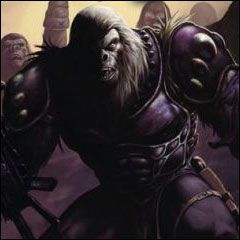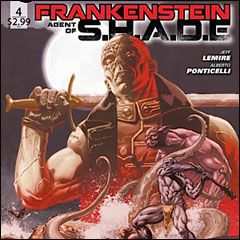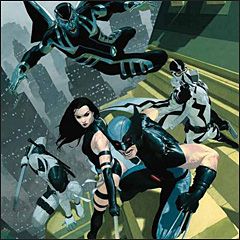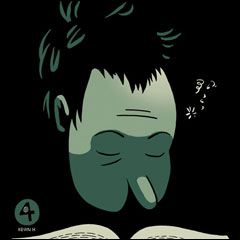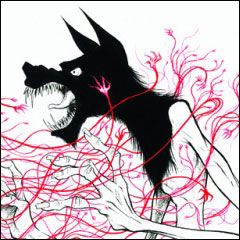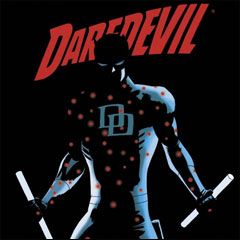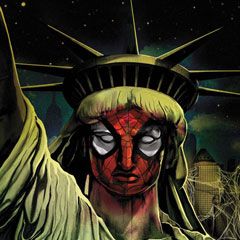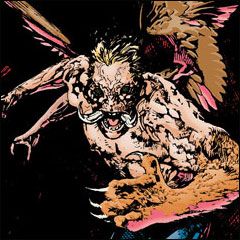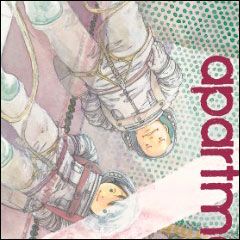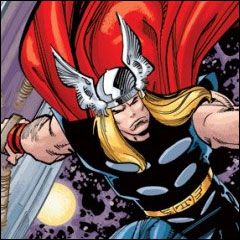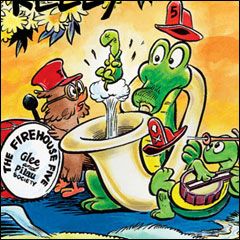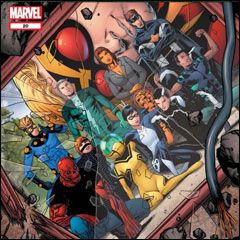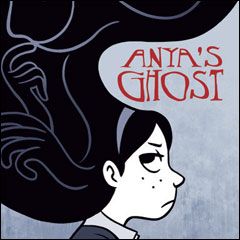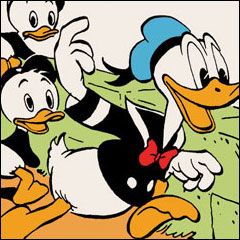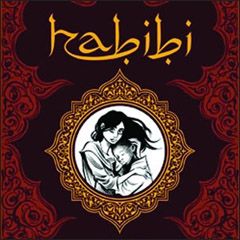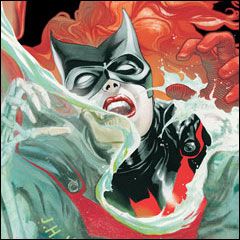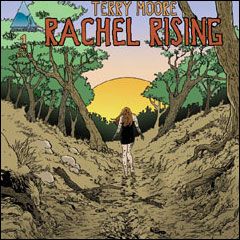As we start to wind down our big birthday bash, I'm always reminded by our year-end "favorite comics" post of just how much variety there is out there in the big world 'o comics, from Uncanny X-Force and Batwoman to Habibi and Love & Rockets, from small press to Big Questions, from Wonder Woman to Mister Wonderful, from Daybreak to American Vampire.
So here are the favorite comic lists from the folks who I have the honor of working with every day on the blog. I like to read these just to see what I missed this year, and maybe come away with a list of stuff to go back and check out. I hope you come away with a similar feeling.
Michael May
1. Planet of the Apes
Written by Daryl Gregory; Drawn by Carlos Magno (BOOM!)
How often does a licensed comic exceed the standards of its source material? We can’t say “never” anymore. Carlos Magno’s lush, detailed art draws the reader into a Planet of the Apes more fantastic than anything we’ve seen on screen. Once there, Daryl Gregory’s story balances adventure and social commentary better than any of the film versions too.
2. Anya’s Ghost
Written and Drawn by Vera Brosgol (First Second)
Anya’s relationship with her ghost is as dysfunctional as the rest of her life and Vera Brosgol’s graphic novel is darker than similar stories in the high school, supernatural-buddy genre. Not that the entire novel is dark. Characters change and grow in positive ways, but any positivity at the end is felt more keenly because of what they had to go through to get there.
3. Pepper Penwell and the Land Creature of Monster Lake
Written and Drawn by Steph Cherrywell (SLG)
Roger Ebert has famously said that no good movie is ever too long. At 200 pages, Pepper Penwell proves that that holds true for comics as well. The laughs, mystery, and adventure are so consistently fun and funny that turning pages becomes a joy and each is as rewarding as the last. It could have gone for another 200 pages and I wouldn’t have minded.
4. Wonder Woman
Written by Brian Azzarello; Drawn by Cliff Chiang (DC)
Wonder Woman fans finally have something to hand to folks who don’t like Wonder Woman.
5. Frankenstein, Agent of SHADE
Written by Jeff Lemire; Drawn by Alberto Ponticelli (DC)
The perfect comic? Or the world’s MOST perfect comic? Takes the coolest monster in the history of horror-fantasy and just pulps the crap out of him. If there was ever a Frankenstein/Atomic Robo crossover, my head would melt like Toht’s in Raiders of the Lost Ark.
6. All-Star Western
Written by Justin Gray and Jimmy Palmiotti; Drawn by Moritat (DC)
Forcing a Western icon like Jonah Hex into an urban setting like nineteenth century Gotham City sounded like an idea with limited potential, but now that I’ve seen the excellent chemistry between Hex and the crime-fighting founder of Arkham Asylum in the first few issues, I’m in no hurry for the disfigured desperado to mosey anywhere else.
7. Supergirl
Written by Michael Green and Mike Johnson; Drawn by Mahmud Asrar (DC)
While it’s taking its time revealing its plot, Supergirl gets exactly right the feel of a young woman struggling to figure out what’s happened to her planet and her past. Credit for that where it’s due to Green and Johnson, but it’s also thanks in a large way to Asrar’s ability to communicate the main character’s personality and emotions through facial expression and body language. That's a skill that should be a lot more common than it is in comics artists, but Asrar's got it down.
8. Orcs: Forged for War
Written by Stan Nicholls; Drawn by Joe Flood (First Second)
They said that they’d change my mind about orcs and they were right. Though I will say that my interest in reading Nicholls’ other, prose, Orcs novels is directly related to how much of Flood’s visuals I’d be able to keep in my head as I do so.
9. Mr. Murder is Dead
Written by Victor Quinaz; Drawn by Brent Schoonover (Archaia)
A surprisingly dark, haunting take on classic comics detectives like Dick Tracy. What I especially like about it is that it’s not as interested in paying homage to crime noir stories as it is just being one itself.
10. Baltimore: The Plague Ships
Written by Mike Mignola and Christopher Golden; Drawn by Ben Stenbeck (Dark Horse)
Readers will undoubtedly get more out of it if they've read Mignola and Golden’s illustrated prose novel first, but the authors do a fine job of keeping the comic self-contained and filling in enough details to explain the world (an alternate reality in which WWI was cancelled on account of vampire-plague) and What’s Come Before (Lord Henry Baltimore may have sort of caused the whole vampire-plague and is hunting the Vampire-in-Charge for reasons having as much to do with Revenge as Saving the World).
Sean T. Collins
20. Uncanny X-Force (Rick Remender and Jerome Opeña, Marvel): In a year when the ugliness of the superhero comics business became harder than ever to ignore, it’s fitting that the best superhero comic is about the ugliness of being a superhero. Remender uses the inherent excess of the X-men’s most extreme team to tell a tale of how solving problems through violence in fact solves nothing at all. (It has this in common with most of the best superhero comics of the past decade: Morrison/Quitely/etc.New X-Men, Bendis/Maleev Daredevil, Brubaker/Epting/etc. Captain America, Mignola/Arcudi/Fegredo/Davis Hellboy/BPRD, Kirkman/Walker/Ottley Invincible, Lewis/Leon The Winter Men…) Opeña’s Euro-cosmic art and Dean White’s twilit color palette (the great unifier for fill-in artists on the title) could handle Remender’s apocalyptic continuity mining easily, but it was in silent reflection on the weight of all this death that they were truly uncanny.
19. The League of Extraordinary Gentlemen Vol. 3: Century #2: 1969 (Alan Moore and Kevin O’Neill, Top Shelf/Knockabout): I’ll admit I’m somewhat surprised to be listing this here; I’ve always enjoyed this last surviving outpost of Moore’s comics career but never thought I loved it. But in this installment, Moore and O’Neill’s intrepid heroes — who’ve previously overcome Professor Moriarty, Fu Manchu, and the Martian war machine — finally succumb to their own excesses and jealousies in Swinging London, allowing a sneering occult villain to tear them apart with almost casual ease. It’s nasty, ugly, and sad, and it’s sticking with me like Moore’s best work.
18. The comics of Lisa Hanawalt (various publishers): As I put it when I saw her drawing of some kind of tree-dwelling primate wearing a multicolored hat made of three human skulls stacked on top of one another, Lisa Hanawalt has a strange imagination. And it’s a totally unpredictable one, which is what makes her comics – whether they’re reasonably straightforward movie lampoons or the extravagantly bizarre sex comic she contributed to Michael DeForge and Ryan Sands’s Thickness anthology, as dark and damp as the soil in which its earthworm ingénue must live – a highlight of any given day a new one pops up.
17. Daybreak (Brian Ralph, Drawn and Quarterly): Fort Thunder’s single most accessible offspring also proves to be its bleakest, thanks to an extended collected edition that converts a rollicking first-person zombie/post-apocalypse thriller into a troubling meditation on the power of the gaze. Future artcomics takes on this subgenre have a high bar to clear.
16. Habibi (Craig Thompson, Pantheon): It’s undermined by its central characters, who exist mainly as a hanger on which this violent, erotic, conflicted, curious, complex, endlessly inventive coat of many colors is hung. But as a pure riot of creative energy from an artist unafraid to wrestle with his demons even if the demons end up winning in the end, Habibi lives up to its ambitions as a personal epic. You could dive into its shifting sands and come up with something different every time.
15. Ganges #4 (Kevin Huizenga, Coconino/Fantagraphics): Huizenga wrings a second great book out of his everyman character’s insomnia. It’s quite simple how, really: He makes comics about things you’d never thought comics could be about, by doing things you never thought comics could do to show you them. Best of all, there’s still the sense that his best work is ahead of him, waiting like dawn in the distance.
14. The Congress of the Animals (Jim Woodring, Fantagraphics): The potential for change explored by the hapless Manhog in last year’s Weathercraft is actualized by the meandering mischief-maker Frank this time around. While I didn’t quite connect with Frank’s travails as deeply as I did with Manhog’s, the payoff still feels like a weight has been lifted from Woodring’s strange world, while the route he takes to get there is illustrated so beautifully it’s almost superhuman. It’s the happy ending he’s spent most of his career earning.
13. Mister Wonderful (Daniel Clowes, Pantheon): Speaking of happy endings an altcomix luminary has spent most of his career earning! Clowes’s contribution to the late, largely unlamented Funny Pages section of The New York Times Magazine is briefly expanded and thoroughly improved in this collected edition. Clowes reformats the broadsheet pages into landscape strips, eases off the punchlines and cliffhangers, blows individual images up to heretofore unseen scales, and walks us through a self-sabotaging doofus’s shitty night into a brighter tomorrow.
12. The comics of Gabrielle Bell (various publishers): Bell is mastering the autobiography genre; her deadpan character designs and body language make everything she says so easy to buy – not that that would be a challenge with comics as insightful as her journey into nerd culture’s beating heart, San Diego Diary, just by way of a for instance. But she’s alsoreinventing the autobiography genre, by sliding seamlessly into fictionalized distortions of it; her black-strewn images give a somber, thoughtful weight to any flight of fancy she throws at us. What a performance, all year long.
11. The Armed Garden and Other Stories (David B., Fantagraphics): Religious fundamentalism is a dreary, oppressive constant in its ability to bend sexuality to mania and hammer lives into weapons devoted to killing. But it has worn a thousand faces in a millennia-long carnevale procession of war and weirdness, and David B. paints portraits of three of its masks with bloody brilliance. Focusing on long-forgotten heresies and treating the most outlandish legends about them as fact, B.’s high-contrast linework sets them all alight with their own incandescent madness.
10. Too Dark to See (Julia Gfrörer, Thuban Press): It was a dark year for comics, at least for the comics that moved me the most. And no one harnessed that darkness to relatable, emotional effect better than Julia Gfrörer. Her very contemporary take on the legend of the succubus was frank and explicit in its treatment of sexuality, rigorously well-observed in its cataloguing of the spirit-sapping modern-day indignities that can feed depression and destroy relationships, and delicately, almost tenderly drawn. It’s like she held her finger to the air, sensed all the things that can make life rotten, and cast them onto the pages. She made something quite beautiful out of all that ugly.
9. The comics and pixel art of Uno Moralez (self-published on the web at unomoralez.com): What if an 8-bit NES cut-scene could kill? The digital artwork of Uno Moralez — some of it standard illustrations, some of it animated gifs, some of it full-fledged comics — shares its aesthetic with The Ring‘s videotape or Al Columbia’s Pim & Francie: a horror so cosmically black, images so unbearably wrong, that they appear to have leaked into and corrupted their very medium of transmission. Moralez fuses crosses the streams of supernatural trash from a variety of cultures — the legends and Soviet art of his native Russia, the horror and porn manga of Japan, the B-movies and horror stories of the States, the formless sensation aesthetic of the Internet itself — into a series of images that is impossible to predict in its weirdness but totally unflagging in its sense that you’d be better off if you’d never laid eyes on it. I can’t wait to see more.
8. The comics of Michael DeForge (various publishers): The last time you saw a cartoonist this good and this unique this young, you were probably reading the UT Austin student newspaper comics section and stumbling across a guy named Chris Ware. All four of DeForge’s best-ever comics — his divorced dad story in Lose #3, his shape-shifting/gender-bending erotica in Thickness #2, his self-published art-world fantasia Open Country, and his gorgeously colored body-horror webcomic Ant Comic – came out this year, none of them looking anything at all like anything you could picture before seeing your first Michael DeForge comic. It’s almost frightening to think where he’ll be five years from now, ten years from now…or even just this time next year.
7. The comics and art of Jonny Negron (various publishers): What if someone took Christina Hendricks’s walk across the parking lot and trip to the bathroom in Drive and made an entire comics career out of them? That is an enormously facile and reductive way to describe the disturbing, stylish, sexy, singular work of Jonny Negron, the breakout cartoonist of the year, but it at least points you in the right direction. No one’s ever thought to combine his muscular yet curiously dispassionate bullet-time approach to action and violence, his Yokoyama-esque spatial geometry, his attention to retrofuturistic fashion and style, his obvious love of the female body in all its shapes and sizes, and his ambient Lynchian terror; even if they had, it’d be tough to conceive of anyone building up his remarkable body of work in such a short period of time. Open up your Tumblr dashboard or crack an anthology (Thickness, Mould Map, Study Group, Smoke Signal, Negron and Jesse Balmer’s own Chameleon), and chances are good that Negron was the weirdest, best, most coldly beautiful thing in it. It’s like a raw, pure transmission from a fascinating brain.
6. The Wolf (Tom Neely, I Will Destroy You): Neely’s wordless, painted, at-times pornographic graphic novel feels like the successful final draft to various other prestigious projects’ false starts. It’s a far less didactic, more genuinely erotic attempt at high-art smut than Dave McKean’s Celluloid; a less self-conscious, more direct attempt at frankly depicting both the destructive and creative effects of sex on a relationship via symbolism than Craig Thompson’s Habibi; a blend of sex and horror and narrative and visual poetry and ugly shit and a happy ending that succeeds in each of these things where many comics choose to focus on only one or two.
5. The Cardboard Valise (Ben Katchor, Pantheon): Prep your time capsules, folks: You’d be hard pressed to find an artifact that better conveys our national predicament than Ben Katchor’s latest comic-strip collection, a series of intertwined vignettes created largely before the Great Recession and our political class’s utter failure to adequately address it, but which nonetheless appears to anticipate it. Its message — that blind nationalism is the prestige of the magic trick used by hucksters to financially and culturally ruin societies for their own profit — is delightfully easy to miss amid Katchor’s remarkable depictions of lost fads, trends, jobs, tourist attractions, and other detritus of the dying American Century. He’s the very most funnest Cassandra around.
4. Love from the Shadows (Gilbert Hernandez, Fantagraphics): I picture Gilbert Hernandez approaching his drawing board these days like Lawrence of Arabia approaching a Turkish convoy: “NO PRISONERS! NO PRISONERS!” In a year suffused with comics funneling pitch-black darkness through a combination of sex and horror, none were blacker, sexier, or more horrific than this gender-bending exploitation flick from Beto’s “Fritz-verse.” None also functioned as a rejection of the work that made its creator famous like this one did, either. Not a crowd-pleaser like his brother, but every bit as brilliant, every bit as fearless.
3. Garden (Yuichi Yokoyama, PictureBox): Like a theme park ride in comics form — with the strange events it chronicles themselves resembling a theme park ride — Yokoyama’s book is a breathtaking, breathless experience. Alongside his anonymous but extravagantly costumed non-characters, we simply go along for the ride, exploring Yokoyama’s prodigious, mysterious imagination as he concocts a seemingly endless stream of increasingly strange interfaces between man and machine, nature and artifice. As a metaphor for our increasingly out-of-control modern life it’s tough to top. As pure thrilling kinetic cartooning it’s equally tough to top.
2. Big Questions (Anders Nilsen, Drawn & Quarterly): Last year, I wrote that if the collected edition of Nilsen’s long-running parable of philosophically minded birds and the plane crash that turns their lives upside-down didn’t top my list whenever it came out, it must have been some kind of miracle year. Turns out that it was. But you’d pretty much have to create a flawless capstone to a thirty-year storyline of neer-peerless intelligence and artistry to top this colossal achievement. Nilsen’s painstaking, pointillist cartooning and ruthless examination of just how little regard the workings of the world have for any given life, human or otherwise, marks him as the best comics artist of his generation, and solidifies Big Questions‘ claim as the finest “funny animal” comic since Maus.
1. Love and Rockets: New Stories #4 (Gilbert and Jaime Hernandez, Fantagraphics): Gilbert got his due elsewhere on my list, so let’s ignore his contribution to this issue, which advance the saga of his bosomy, frequently abused protagonist Fritz Martinez both on and off the sleazy silver screen. Instead, let’s add to the chorus praising Jaime’s “The Love Bunglers” as one of the greatest comics of all time, the point toward which one of the greatest comics series of all time has been hurtling for thirty years. In a single two-page spread Jaime nearly crushes both his lovable, walking-disaster main characters Maggie and Ray with the accumulated weight of all their decades of life, before emerging from beneath it like Spider-Man pushing up from out of that Ditko machinery. You can count the number of cartoonists able to wed style to substance, form to function, this seamlessly on one hand with fingers to spare. A masterpiece.
Matt Seneca
1. Color Engineering, by Yuichi Yokoyama
2. Garden, by Yuichi Yokoyama
3. Affected, by Matt Seneca
4. Obsolete, by Mikkel Sommer
5. 2001, by Blaise Larmee
6. Kramers Ergot 8, edited by Sammy Harkham
7. Daredevil, by Marvel Comics
8. Thickness, edited by Ryan Sands and Michael DeForge
9. SF, by Ryan Cecil-Smith
10 (tie). Ganges #4, by Kevin Huizenga AND Love & Rockets New Stories #4, by Los Bros Hernandez
Tom Bondurant
My list comes with the standard caveat that I didn’t read a huge chunk of what were undoubtedly some good-to-great comics. In fact, as you might expect, I concentrated pretty heavily on a certain publisher. Nevertheless, here’s what I liked most out of the past year.
Honorable mentions go to (shocker!) a couple of DC superhero comics. Zatanna didn’t make it into the big relaunch, but while it lasted it was an entertaining look at a character who rarely gets her own spotlight. Both fun and suspenseful, regular writer Paul Dini fleshed out Zee’s roster of adversaries and her supporting cast, most notably in an eerie arc (drawn by Cliff Chiang) which found our heroine trapped in puppet form. While 2011 was also a big year for The Flash, the title only kicked into high gear with the September relaunch. Penciller (and co-writer) Francis Manapul used Barry Allen’s clean slate to explore visually the nature of super-speed, playing freely with page layouts and storytelling techniques to help the book live up to its name.
10. Wonder Woman (written by Phil Hester from plots by J. Michael Straczynski and drawn by Don Kramer and various artists; then written by Brian Azzarello and drawn by Cliff Chiang). It was a weird year for Wonder Woman. 2011 began in the middle of the altered-timeline “Odyssey” story, with Diana a tough-talking fugitive (in a new costume) and the Amazons decimated. It was the kind of story which practically dared the reader to wait for a reset, but Hester, Kramer, and company turned it into a nice meditation on the character’s archetypal nature. Moreover, the reset which followed “Odyssey” didn’t exactly restore Diana’s traditional status quo. Instead, Azzarello and Chiang doubled down on her mythological background, plunging readers into a Hellenistic horror show with Wonder Woman holding the line between humanity and the capricious gods. I’ll read just about anything Cliff Chiang does, but he really turned it up for this series, making the new-look Wonder Woman formidable as ever right out of the gate.
9. Xombi (written by John Rozum, drawn by Frazer Irving). Between its wild concepts and Irving’s sublime art, this relaunch of a fondly-remembered Milestone title made the most of its six-issue run. David Kim and his allies confronted new (and surreal) threats to existence itself, and handled them with aplomb. If this series had found a wider audience via the New-52 treatment, we’d no doubt be looking forward to years more with David, Catholic Girl, Nun of the Above, et al. As it stands, I’ll just have to hunt up those back issues from the ‘90s.
8. Amazing Spider-Man (written by Dan Slott, drawn by Humberto Ramos and others). I have a strange relationship with the Spider-Man comics: I can only seem to read them regularly in decades-old reprints. The last time I made Amazing Spider-Man a monthly habit, David Michelinie and Todd McFarlane were on the book. However, after jumping aboard with the “Big Time” arc, it’s been a pretty good ride so far. ASM excels as a superhero serial, balancing Spidey’s adventures skillfully against Peter’s more mundane worries. Indeed, Slott seems to have swapped Peter’s classic set of troubles (Aunt May, steady paychecks, etc.) for some which carry with them the burden of maturity. The just-concluded “Spider-Island” was an excellent example of this, using both Mary Jane and new girlfriend (to me, at least) Carlie Cooper to good effect. Amazing Spider-Man isn’t a slavish reworking of some long-ago status quo, designed to satisfy lapsed readers from the ‘70s and ‘80s. It’s as nimble and sure-footed as its star.
7. The Unwritten (written by Mike Carey, drawn by Peter Gross). By now it’s old hat to note that this series has grown far beyond its Harry-Potter-inspired beginnings. In fact, by now The Unwritten has set its sights on the very nature of fiction, as Tom Taylor wages war against an evil cabal which wants to control society through stories themselves. The “guest stars,” which this year included a Golden Age superhero and Gilgamesh, are no less compelling. The Unwritten is not only one of the most intelligent comics I read in 2011, it’s one of the most intelligent, period.
6. “Jimmy Olsen’s Big Week” (written by Nick Spencer, pencilled by R.B. Silva with Amilcar Pinna, inked by DYM, Rob Lean, and Pinna). Serialized initially in the back of Action Comics, I said in April this might as well have been called Superman’s Pal Scott Pilgrim. Lots of folks have tried to meld the wackiness of Jimmy’s Silver Age adventures with more “modern” sensibilities (Countdown, anyone?), but Spencer and Silva hit it out of the park. Although they made Jimmy harried and put-upon, they also made him pretty good at dealing with the kinds of weirdness which literally seem to pop up every day in Metropolis. Consistently funny and ultimately satisfying, “JOBW” was a highlight of pre-relaunch DC.
5. American Vampire: Survival of the Fittest (written by Scott Snyder, drawn by Sean Murphy). Don’t get me wrong -- the main American Vampire series is always a treat. However, I especially liked how this spinoff miniseries distilled the best parts of AV into a potent concentrate, and filtered that through the kind of World War II story you only see in superhero comics. Still, while the climactic action sequence is equal parts Indiana Jones and Captain America, the story is driven emotionally by the desperation only parents can feel about the welfare of their child, and Snyder and Murphy don’t let the monsters and Nazis overwhelm that.
4. Animal Man (written by Jeff Lemire, drawn by Travel Foreman). Speaking of desperate parents, one of the New-52 relaunches I least expected to see turns out to be one of the year’s more thrilling superhero stories. Lemire and Foreman move easily between the Baker family’s domestic trials, Buddy’s sputtering superhero career, and the nightmare landscapes where the two intersect. Animal Man casts the Bakers, and its readers, into worlds for which they only think they’re prepared; so it’s only fitting to pair it with...
3. Swamp Thing (written by Scott Snyder, drawn by Yanick Paquette). Honestly, with his Batman work and American Vampire proper, there could easily have been more Scott Snyder on this list; but I didn’t think that was entirely fair. Regardless, I couldn’t ignore Snyder and Paquette’s slow-burn take on the character who became one of Vertigo’s founding fathers, now reincorporated into the superhero realm. Appropriately enough, this volume of Swamp Thing is one of the rare books which takes everything you knew about the character and turns it inside-out so adroitly that you have no choice but to keep reading.
2. Batwoman (written by J.H. Williams III and W. Haden Blackman, drawn by Williams). Barely missing a beat since she left Detective Comics, Kate Kane’s solo title is still one of the best-looking superhero comics of this or any other year. Although original writer Greg Rucka is no longer guiding her adventures, Williams and Blackman have juggled Kate’s relationships skillfully. She’s now a mentor (to the precocious Flamebird), a girlfriend (to the GCPD’s Maggie Sawyer), a target (of the cult-favorite Cameron Chase), and an estranged daughter. Batwoman is grown-up without being prurient, hyperviolent, profane, or pedantic, and it stands out among the New 52.
1. Hark! A Vagrant (by Kate Beaton). I had Kate Beaton’s wonderful webcomic on my 2010 list, and I see no reason to take it off this year. In 2011, Ms. Beaton came into her own, navigating various media on behalf of the eponymous H!AV hardcover. Good for her, I say; she is a singular talent who deserves all the recognition she’s garnered for her work. The only drawback to all this attention was that we seemed to get fewer new comics this year. Hark! A Vagrant is reliably funny, whether it’s making witty jabs at historical figures or having Batman “go undercover” in assless chaps. Here’s hoping we have more from Ms. Beaton for many years to come.
Brigid Alverson
1. Ivy: Sarah Oleksyk's abrasive heroine feels out of place in her small Maine town, but her attempt to escape ends disastrously. This unsparing story of teenage alienation is the opposite of the sanitized young adult novel about growing up and learning lessons; it feels very, very real, and it's hard not to like Ivy despite her faults.
2. Onward Towards Our Noble Deaths: Shigeru Mizuki draws on his own experiences in the Japanese army in this unsparing look at a doomed unit sent on a suicide mission in the last days of World War II.
3. Saturn Apartments: This manga is a series of short stories about a window washer for a strange, ring-shaped apartment complex that orbits the earth. You don't have to be a sci-fi fan to appreciate creator Hisae Iwaoka's oddly structured world, his quirky characters, and his lushly drawn spaces.
4. Amelia Rules: The Meaning of Life (and Other Stuff): The first Amelia Rules book was all about adjusting to big life changes; this one is about learning to deal with the subtler changes that come with growing up. The characters remain charmingly down to earth, and Gownley's storytelling is stronger than ever.
5. One Soul: Ray Fawkes has created a complex masterpiece, 18 stories told in a grid format that emphasizes the parallels and patterns that unite the different characters. It sounds terribly artsy and high-concept, but each of these 18 characters has a compelling story as well, and Fawkes brings them together in a very readable and thought-provoking book.
6. The Green River Killer: Creepy without being gratuitous, this nonfiction graphic novel is really a police procedural, focusing on the dynamic between the murderer and the detectives who worked the case.
7. The Last Dragon: With a retro art style reminiscent of N.C. Wyeth, this book looks too beautiful to be funny. Wrong! It's a fairy tale about a smart girl and a handsome blowhard who team up to save a village from a dragon, told with warmth and plenty of wit.
8. Chimichanga: Eric Powell takes a standard children's story—a little girl and her pet monster—and makes it new again by giving the girl a beard (that has miraculous fart-preventing powers) and setting his story in the lamest circus ever. Beautifully colored by Dave Stewart, this is that rare comic that actually deserves the term "all ages."
9. Blackjacked and Pistol-Whipped: A Crime Does Not Pay Primer: Editor Denis Kitchen kicks off this compilation of 1940s comics with an essay about the seedy side of the publisher himself, then turns it over to the criminals and their victims. The comics are terribly dated, which just gives them more charm, but a good yarn is still a good yarn, even 60 years later.
10. Life With Archie: The Married Life: Look, I know it's not highbrow, but these are the comics I couldn't put down. Paul Kupperberg has woven a great soap opera and updated the classic characters in ways that seem logical in retrospect but that I never would have predicted from their earlier incarnations.
Tim O'Shea
15. The Mighty Thor Walter Simonson Omnibus (Marvel). Sure, this book originates in the 1980s. But this omnibus, with new coloring and in one bound volume captures one of my favorite runs of all time by writer/artist Simonson (as well as featuring some of the best work of letterer John Workman and artist Sal Buscema). I only wish series editor Mark Gruenwald (who tapped Simonson to tackle the assignment) were still alive to see this book in all its Norse by way of Marvel mythological masterpiece.
14. Sketchbooks, Chris Schweizer (Curious Old Library). The Crogan Adventures writer/artist and SCAD Atlanta professor intends for this to partially be a teaching tool. And it delivers on that goal. But it’s also entertaining as hell. For example, a sketch from a James Jean workshop had him advising the SCAD students: “The only way to be a successful artist is to not get married. Or be divorced.” This advice was met with laughter, assuming it was in jest, prompting Jean to add: “I’m not kidding.” And the text pieces are almost as entertaining and informative as the art. Finally am I the only one that is reminded of Alex Toth’s lettering (a little) when looking at Schweizer’s lettering? (Admittedly Schweizer’s lettering is far less angular than Toth’s, but I see kindred spirits in lettering at least).
13. Red Skull Incarnate, writer: Greg Pak; artist: Mirko Colak (Marvel). This is likely the most sobering comic book series that Marvel will ever publish, solely because this five-issue Red Skull origin miniseries, partially rooted in real world events (pre-WWII German history). I have enjoyed Greg Pak’s writing in recent years, but this ambitious project earned me a new level of respect for his work.
12. Xombi, writer: John Rozum; artist: Frazer Irving. Every once and awhile, a series will have a quirkiness that reminds me of Grant Morrison’s Danny the Street (from his Doom Patrol run). Rozum and Irving hooked me with the first issue, despite the fact I never read the previous 1990s incarnation of Xombi.
11. Secret Avengers, writer: Warren Ellis (Marvel). In the age of event comics, where crossovers ad nauseum are the norm, Ellis delivered several done in one stories. Granted his nontraditional approach to some characters may slightly irritate traditionalists, but when Ellis sets his mind to write stories with team dynamics and dialogue, few are better than him.
10. Superman, writer: Chris Roberson, writer; Jamal Igle, artist (DC). He took a poorly constructed arc and made the series a must read. Of the many titles that ended to make way for the new 52, I wish I was still reading a Roberson-written Superman.
9. POGO Through the Wild Blue Yonder, writer/artist Walt Kelly (Fantagraphics). Damn if this was not worth the wait, the long (understandably and arduous) long wait. Volume 1 of the complete syndicated daily strips of POGO would be enough to put this book on my list. But the fact that Fantagraphics has a foreword by Jimmy Breslin; an introduction by Steve Thompson; a piece on the POGO Sunday Funnies by Mark Evanier; and Swamp Talk (R.H. Harvey annotations on the strips) is just icing on the cake. For those of you wondering how good the Harvey annotations are? Fantagraphics offers an online unexpurgated version of the annotations.
8. Batgirl, writer: Bryan Q. Miller, writer; Pere Perez, artist (DC). In 2012, there will be plenty of time to praise Simone’s Batgirl, but I find myself unable to forget the greatness of Miller’s 24-issue run on Batgirl. The writer is to also to be commended for the great coda he gave to the series in the final issue, where he gives readers a glimpse of what was to come.
7. Hark! A Vagrant, writer/artist: Kate Beaton (Drawn & Quarterly). Kate Beaton is the closest thing to Bill Simmons that we have in comics. Comedy with footnotes and/or subtext that makes you laugh and think.
6. Daredevil, writer: Mark Waid, artists: Marcos Martin, Paolo Rivera, & Joe Rivera (Marvel). After reading the first issue I felt as hopeful and engaged as I did in the early 1980s when absorbing Walt Simonson’s Thor #337 (the first issue in his epic run). The most refreshingly joyful approach to the character in decades, and I have enjoyed each subsequent issue as much as the first.
5. Gladstone’s School for World Conquerors, writer: Mark Andrew Smith; artist: Armand Villavert (Image). The concept itself, children of villains attending a school where they believe they are being educated for one thing while the truth reveals itself slowly, is a premise that offers the creators and consumers both a great deal of potential opportunities. Where the story has gone so far has left me clamoring for more.
4. Super Dinosaur, writer: Robert Kirkman; artist: Jason Howard (Skybound/Image). In an industry where all ages books are viewed by many as a label that curses a series, Kirkman seems to embrace the all ages concept with this series. Buy what makes this series a must read for people of all ages is the vibrant energy running throughout Howard’s art.
3. Avengers Academy by Christos Gage, writer (Marvel). Gage’s approach to Hank Pym, as well as the fully developed teenage characters, is why I consider this the best Avengers title that Marvel publishes (and is the only Avengers-related book I buy).
2. Centifolia II: The Sketchbook Illustrations of Stuart Immonen (AdHouse). When is a sketchbook more than a sketchbook? When it involves the work of Immonen, an artist of many styles and approaches. Only Immonen would include two short stories, the majestically colored "Say You’re Dead" and the black and white "Jeopardy Jones," in a sketchbook.
1. Hulk, writer: Jeff Parker; artist: Gabriel Hardman; colorist: Elizabeth Breitweiser (Marvel). Name another modern day superhero series in which the writer works in a moment where the lead character expresses his admiration for George Washington, Ulysses S. Grant, Teddy Roosevelt and Dwight D. Eisenhower. Parker remains one of the strongest writers working at Marvel, with the Hulk being his best runs to date.
Chris Mautner
1. Love and Rockets New Stories Vol. 4 by the Hernandez brothers -- The hype and acclaim surrounding Xaime Hernandez's conclusion to his "Love Bunglers" saga has been overwhelming, and every ounce of it is deserved. This is simply a phenomenal achievement in comics. A moving, thoughtful story of missed opportunities, loss and eventual reconciliation that provides in many ways a fitting conclusion to all of Xaime's "Locas" stories. I'd be hard pressed to think of a better comic that came out this year.
2. Garden/Color Engineering by Yuichi Yokoyama -- I'm cheating here a bit, but the one-two punch that Yuichi Yokoyama delivered this year was a knockout in terms of rethinking what comics can do with color and motion. Eschewing things like plot, characters and traditional narrative, Yokoyama manages to nevertheless create utterly compelling and even exciting comics about exploring odd, man-made structures. Exploration and discovery are the key tenants of his comics and it makes for rich, fascinating work.
3. Lose #3 by Michael DeForge -- 2011 saw a lot of cartoonists returning to the pamphlet format with great success, most notably perhaps DeForge, who has garnered a small but strong following in an incredibly short amount of time on the basis of his unique art style and his utter willingness to completely creep out the reader. Lose #3 is just one more example of how talented and daring this young creator is.
4. Congress of the Animals by Jim Woodring -- As with Woodring's previous book, Weathercraft, Congress finds one of the central characters in the author's surreal Unifactor world, in this case Frank, going on a lengthy journey and coming back having altered his world somehow, though in this case the changes seem to be permanent. It takes a bit of daring to be willing to alter the status quo in a respected body of work and considerable talent to be able to do so in as assured manner as Woodring does here.
5. Pope Hats #2 by Ethan Rilly -- The alt-pamphlet can't be truly dead and buried when artists like Ethan Rilly are making such wonderful comics with the format. Rilly's central tale about a woman facing a crossroads both in her career and life sounds like it would make for dull reading, but the complete opposite is true. He sharply observed, nuanced characters that are filled with detail and excellent cartooning. I can't wait to see what Rilly does next.
6. Anya's Ghost by Vera Brosgol -- Brosgol's young adult story, about a girl who encounters a friendly spectre that slowly turns sinister, mangoes to pack a lot of wisdom about adolescence, peer pressure and desire without ever once coming off as a cloying, afterschool TV special. Plus, she's got great chops, I could stare at one of her page compositions for hours.
7. Chimo by David Collier -- Collier is a hell of a rambling, idiosyncratic storyteller, and his comics as a result can be tough to burrow into. Tough but in the case of his latest work, perhaps his best to date, very rewarding as he casts a scant eye on middle age, mortality and the failings of the body with the rigors of military life as Collier re-enlists with the Canadian forces, perhaps in an effort to attain youth again. Though frequently digressive, it's never anything less than engrossing.
8. Pinocchio by Winshluss -- In some ways this book has a very "old-school" flavor, especially in its "take no prisoners" satirical attitude towards the government, the military, people in general and fairy tales in particular. Winshluss' art is so lush and vibrant, however, and his timing so spot-on that far from a trite nostalgia-fest, Pinocchio seems fresh, vibrant and very, very funny.
9. Optic Nerve #12 by Adrian Tomine -- Tomine jumped back on the pamphlet bandwagon with this new, self-contained comic. While the story "Amber Sweet," originally seen in Kramer's Ergot 7, holds up find even in a smaller, black and white format, it's the other story, "A Brief History of the Art Form Known as Hortisculpture" that's the real gem, as Tomine explores in humorous fashion the travails of attempting to create art and the nagging underlying feeling that you are completely ill-suited to do so.
10. Mickey Mouse Vol. 1 by Floyd Gottfredson -- More than the new Carl Barks collection, more than the return of Pogo, the resurrected, re-appreciated comic strip I found myself falling in love the most with this year was Gottfredson's plunky, adventure-loving mouse, a scrappier version of Disney's iconic creation. More to the point, I was completely taken with the stunning packaging and background information Fantagraphics and the books editor put together for this series. It's new benchmark for reprint projects.
11. The Cardboard Valise by Ben Katchor -- Like, Collier, Katchor can take some getting used to; his work can seem oddly dense or even off-putting at first glance. Once you've spent time in his world, however, it's easy to get lost in it. His latest book, full of hucksters, self-help gurus, peculiar ports of call and oddball obsessive types is an off-kilter delight.
12. Big Questions by Anders Nilsen -- How many years did Nilsen work on his little bird saga? A million? No matter, the end result is well worth the time spent. Big Questions is not necessary Nilsen's finest work to date (that would be "The End") but it's an amazing achievement nevertheless. A animal fable that slowly builds and unwinds as it dares to ask uncomfortable questions about our own place in the universe. It's a haunting, poetic work that calls to mind authors like Samuel Beckett and Kurt Vonnegut and a thrilling achievement in its own right.
13. 1-800-MICE by Matthew Thurber -- Thurber's tale of different warring factions in a small community and the individuals who attempt to contain or manipulate various sides is like a lengthy fever dream that unravels just when it starts to make sense. By turns hilarious and disturbing, it never runs off the rails or devolves into self-indulgent silliness but manages to keep its own unique and captivating vision consistent throughout.
14. Ganges #4 by Kevin Huizenga -- The arrival of a new issue of Ganges is always a treat and this one, a continuation of lead character Glenn Ganges' ever-failing attempts to get a decent night's rest, is no exception.
15. Prison Pit Vol. 3 by Johnny Ryan -- Three volumes into this grand guginol series and it continues to surprise and delight, this time introducing a new character and suggesting via an end sequence that Ryan has been reading a lot of Fort Thunder comics.
16. Lost in the Andes by Carl Barks -- You know what's great about the current state of comics? That I can create a "best of" list that puts Prison Pit and this book next to each other. Do I really have to explain at this point why Carl Barks matters or how nice it is to finally see an affordable book-length collection of his work? Can't wait for volume 2.
17. The Cabbie by Marti -- In his interview with Tom Spurgeon, publisher Kim Thompson described this as "Dick Tracy on crank" that's about as good a description of this fever-pitched crime noir tale as I can come up with.
18. The Man Who Grew His Beard by Oliver Schrauwen -- Incredibly inventive, Schrauwen, like Yokoyama, seems intent on pushing the comics medium into new and interesting directions. But where Yokoyama is concerned mainly with motion and exploration, Schrauwen is concerned mainly with perception and the interior world of the mind. This is great, mind-blowing work.
19. Casanova: Avaritia by Matt Fraction and Gabriel Ba -- While I hadn't been following Fraction's work-for-hire material (my monthly comic fund being rather tight this year) I hotly anticipated/dreaded the latest Casanova saga. The previous collection had been so strong, so well-thought out and emotionally powerful, I wasn't sure if he'd be able to maintain that level of quality. I needn't have worried.
20. Habibi by Craig Thompson -- I'd be lying if I said Thompson's brick of a graphic novel was perfect -- it's got some serious flaws, most notably its handling of various Orientalist myths and prejudices which it brings up but never really addresses in any concrete manner. At the same time, it's difficult not to be impressed by Thompson's lush, ornate designs and drawings and his willingness to reach for grandiose themes and statements. It's a divisive book in some ways, but Habibi nevertheless confirms Thompson as not just a flash in the pan but an artist whose work is worth examining and taking seriously.
Other good books I feel bad about not mentioning: Everything Vol. 1 by Lynda Barry; Kramer's Ergot 8; Gangsta Rap Posse #2 by Benjamin Marra; Hark! A Vagrant by Kate Beaton; Love from the Shadows by Gilbert Hernandez.
Carla Hoffman
In no particular order because my heart is so full that I can love all these comics with equal ferocity, my top ten of 2011:
Fear Itself: I might be a lone voice in the crowd, but hot damn I loved Fear Itself. A long-forgotten Asgardian god rises from below thanks to meddling Nazis, hurls the planet into chaos and fear. Our heroes, facing this impact on all of humanity, go through a lot of feelings. Sometimes it's "We got to nut up or shut up," sometimes it's "I need to see my family," sometimes it's "it's the end of the world and I do not know what to do." Everyone played brilliantly and required so much of an emotional connection to the characters and events that it rose above the "buy this book for a series of marketable points!" milieu of past event titles. At the end, the Serpent was defeated at a great cost, locked away in Asgard to bring about a new era for the heroes, some personal and some ...location-ally. I can see that this rather broad approach might not have connected with a lot of people and that some of the tie-ins were rather atrocious, but as a core story? As a great grand thematic drama that unfolded page after page and pulled me in as a reader? This was it.
Batwoman: A little DC love, I have to say that Batwoman is brilliant. It's everything I want out of a 'Batman' style book: great moody visuals, mystery and something a bit bigger than a cop drama, romance, sidekicks, secret identities that are both deep and complex. The book even starts with a few sentences about the hero you're about to read, marvelously preparing the audience for who's inside. Some pages and panels have an almost dream-like quality forcing your eye to really take in what a comic can look like as a piece of art. If I had to say anything against it, I'd say Batwoman doesn't seem to jibe with the rest of the 52, but that's just fine with me.
Ultimate Comics: All-New Spider-Man: Marvel's not that great about taking established characters and putting new people in an old costume. Aside from BuckyCap, the style of Marvel storytelling didn't allow for it because there was just too much focus on who the man behind the mask was. Peter Parker, the Spectacular Spider-Man, right there on the cover. So, for Miles Morales, we start small. We get to know this guy, his history on a personal level and learn to relate to someone who's eventually going to be the lynchpin of the Ultimate universe. New readers love inception, the moment in which the common man rises to the occasion to take on super-hero status and Bendis is doing it all with such ease. I wish this book got constant press and was debated more than Wonder Woman's pants, but not for the new #1 on its cover, but the content within.
Black Panther: the Man without Fear/Dangerous Man Alive: This wasn't the Daredevil book we wanted, but it was the Daredevil book we needed. We needed to see a man, stripped of title and pretense, fight crime on the streets. T'Challa got sort of a clean sweep when he got this book and, in his isolation, grew into a more personable character than the King of Wakanda was for me. The Fear Itself tie-ins was layers upon layers of weighty topics (fear of the outsider, distrust, co-opting our very costume into a rallying point for the Hate Monger) all drawn with this deep moody feel. I agree that the numbering was in poor taste after Daredevil left, but looking back now, I can't say that it didn't make a kind of sense.
Uncanny X-Force: This, my friends, is what an X-Book should be. Maybe it's because I grew up in the 90s and that the X-Men were all about fighting some big, external threat and people got taken over and there was all that love triangle-ing, like a big over dramatic science fiction soap opera with this fine sheen of morality hair spray on top. And while the Distinguished Competitors might be trying to capture that era in style, Remender is doing it in mood and theme. There is no gloss to these pages, just Jerome Opeña's rich pencils and the moody colors over them. I have thrilled to each issue and have been delighted by their surprises. My only disappointment is that the book is not made out of delicious chocolate.
PunisherMAX: It was a super hard choice between this book and Greg Rucka's fantastic relaunch of the 'regular' Punisher series, but Jason Aaron has made me see things I cannot ever unsee. PunisherMAX has in its pages a terrible story and a brutal fight between himself and Bullseye this year, and the retelling of Frank Castle's origin still haunts me. Steve Dillion is an artist you have to acquire a taste for, like beer, but boy howdy can he mess you up on some nights with his hard hitting action and honest faces. It may not be the prettiest Punisher stories you'll ever read. It may not even be the toughest son of a gun you'll ever meet, but PunisherMAX is most certainly raw.
Daredevil: The comeback kid! As much as I love Black Panther's turn as the defender of Hell's Kitchen, Mark Waid is untouchable (put it on a t-shirt) for bringing a new renaissance to the Man without Fear. Each issue is a joy, with compelling stories, unique visuals and color! GOD, COLOR! No a single muddy line or ruined shadow. Better people than I can sing his praises, but if you aren't reading this book than you are missing out on a brilliant, brilliant moment in comics.
Avengers Academy: In my record, there is only one Avengers title that truly earns the name and that is Avengers Academy. All the classic elements are there, plus the added addition of adolescent angst that was missing from the usual stage of the X-Men comics. Christos Gage continues this year, as he does every year, to reach out to the reader through new and old characters alike and bring story out of spectacle. In direct contrast to Uncanny X-Force, Gage also adds layers of mystery and morality to his stories, but I never feel like I'm left in the dark. I'm always in on what's going on but still surprised and excited for the next issue. I know Bendis' new era has brought a lot of fans and done wonders for Earth's Mightiest Heroes, but this book is the one that defines what that title means for me.
Rachel Rising: Terry Moore brings it best on his creator-owned work, and Rachel Rising is no exception. The first pages of this series as a girl climbs up out of what seems to be her own grave are chilling and expertly told without a single line of explanation; if taking in the depth of expression and scene-setting that comes out of Moore's classic style doesn't make you grasp for what's to come next then I will politely escort you to Liefeld's Hawk and Dove. As he did with Echo, Moore is once again carefully arranging a new world of people and concepts and it's a great thing to watch unfold. The reason Echo isn't here on this Top Ten is that I felt the super-science-ness of it all and changes made to the characters were far too radical for me to hold on to. At least with Rachel Rising, there seems to be a more deliberate attempt to make this a story of a more personal horror.
Tiny Titans: Every month it comes out it is the first comic I read from my pull. We all need a little humor and a way not to take any of this New 52 too seriously and Tiny Titans is the breath of fresh air after all the weighty drama and intellectual hammer smashing I need to keep my head on straight. Aw yeah, Titans!


